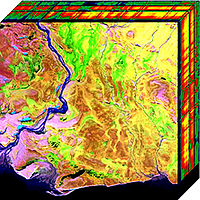
Photo from wikipedia
In hyperspectral imagery, differences in ground surface structures cause a large variation in the optical scattering in sunlit and (partly) shadowed pixels. The complexity of the scene demands a general… Click to show full abstract
In hyperspectral imagery, differences in ground surface structures cause a large variation in the optical scattering in sunlit and (partly) shadowed pixels. The complexity of the scene demands a general spectral mixture model that can adapt to the different scenarios of the ground surface. In this article, we propose a physics-based spectral mixture model, i.e., the extended shadow multilinear mixing (ESMLM) model that accounts for typical ground scenarios in the presence of shadows and nonlinear optical effects, by considering multiple illumination sources. Specifically, the diffuse solar illumination alters as the wavelength changes, requiring a wavelength-dependent modeling of shadows. Moreover, we allow different types of nonlinear interactions for different illumination conditions. The proposed model is described in a graph-based representation, which sums up all possible radiation paths initiated by the illumination sources. Physical assumptions are made to simplify the proposed model, resulting in material abundances and four physically interpretable parameters. Additionally, shadow-removed images can be reconstructed. The proposed model is compared with other state-of-the-art models using one synthetic dataset and two real datasets. Experimental results show that the ESMLM model performs robustly in various illumination conditions. In addition, the physically interpretable parameters contain valuable information on the scene structures and assist in performing shadow removal that outperforms other state-of-the-art works.
Journal Title: IEEE Journal of Selected Topics in Applied Earth Observations and Remote Sensing
Year Published: 2022
Link to full text (if available)
Share on Social Media: Sign Up to like & get
recommendations!